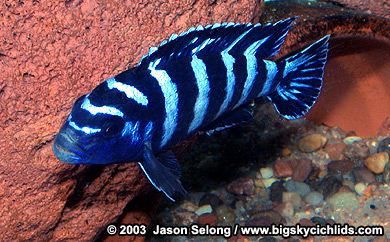|
|
||
|
|
Systematics. The genus Pseudotropheus was formerly used for a variety of Lake Malawi mbuna species. Recent revisions split the genus into three sub-genera (Pseudotropheus (Pseudotropheus), P. (Tropheops), and P. (Metriaclima) [Note: Metriaclima -or Maylandia; depending upon which arguments you follow; see Cichlid Fish of Lake Malawi or Cichlid-Forum for info. on this debate- has been given full genus status]. P. demasoni was described by Konings (1994) from Pombo Rocks, Lake Malawi, and belongs to the Pseudotropheus (Pseudotropheus) complex.
Pseudotropheus demasoni dominant male 85 mm TL
Natural Habitat. P. demasoni, described from the Pombo Rocks location off the Tanzanian coast of Lake Malawi, is generally grouped with the "dwarf" Pseudotropheus which includes P. saulosi, P. sp. "red-top ndumbi", and P. sp. "polit" to name a few. More recently, a probable variant of P. demasoni has been found further south in Lake Malawi off the coast of Mozambique. This variant has been dubbed P. demasoni "mozambique"
Captive Maintenance. The small adult size (maximum 75 mm) and striking blue-black coloration makes P. demasoni an attractive captive specimen, however, high interspecific aggression creates difficulty in maintaining this species. P. demasoni is monomorphic and both males and females are similarly colored. Males and females are often nearly the same size, however males generally have elongated ventral fins and a more conspicuous egg spot. P. demasoni begin to mature at approximately 25 mm (1.0 inches) and spawning has been reported in females of this size. P. demasoni are very aggressive even at this size and torn fins are the norm for maturing fry. Large group sizes of ten or more and plenty of cover are key to maintaining this species. P. demasoni could probably be maintained in aquaria as small as 120 L (30 gallons) with heavy cover, but larger tanks (at least 200 L) are recommended. I previously maintained a group of nine (2M/7F) in a 220 L (55 gallon) tank with ample rockwork. Tankmates include Labeotropheus trewavasae, Labidochromis caeruleus, Protomelas sp. "steveni taiwan", and "Haplochromis sp.44". P. demasoni, due to their small size at maturity, were first to spawn in this tank and have continued to spawn even as some of the larger inhabitants have matured and outgrown them. Note: The L. trewavasae and P. "steveni taiwan" eventually inhibited the P. demasoni from spawning when the former had reached full adult size. The P. demasoni resumed spawning when both species were removed. Currently a 220 L aquarium with 18 adult P. demasoni and 5 adult Tropheus sp. "ikola" is being maintained. The Tropheus are larger and quite aggressive, however, the P. demasoni are continually successful in spawning perhaps due to their large number. The males of each species continually engage each other with little harm and aggression has been reduced on the females of each species. Spawning is similar to other maternal mouthbrooders and fecundity generally ranges from 5 - 15, depending upon female size. Hatching occurs in approximately seven days at 80 F, and fry are free swimming by day 20. Fry will readily accept crushed flake and hatched artemia. Care should be taken not to mix broods of new fry as even slightly larger individuals will consume smaller fish.
Literature
Cited Konings, A. 1994. Pseudotropheus demasoni sp. nov.: a sexually monomorphic cichlid from the Tanzanian coast of Lake Malawi. The Cichlids Yearbook, Volume 4: 24-27. Cichlid Press, St. Leon-Rot, Germany; 96 pp.
|
|
|
Home l Update l Stock List l Gallery | Lake Malawi l Lake Tanganyika l Lake Victoria l Articles l References l Links l About | Contact
© Copyright 1999-2012 All rights reserved.
|
||
